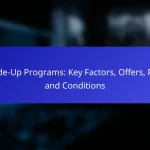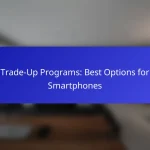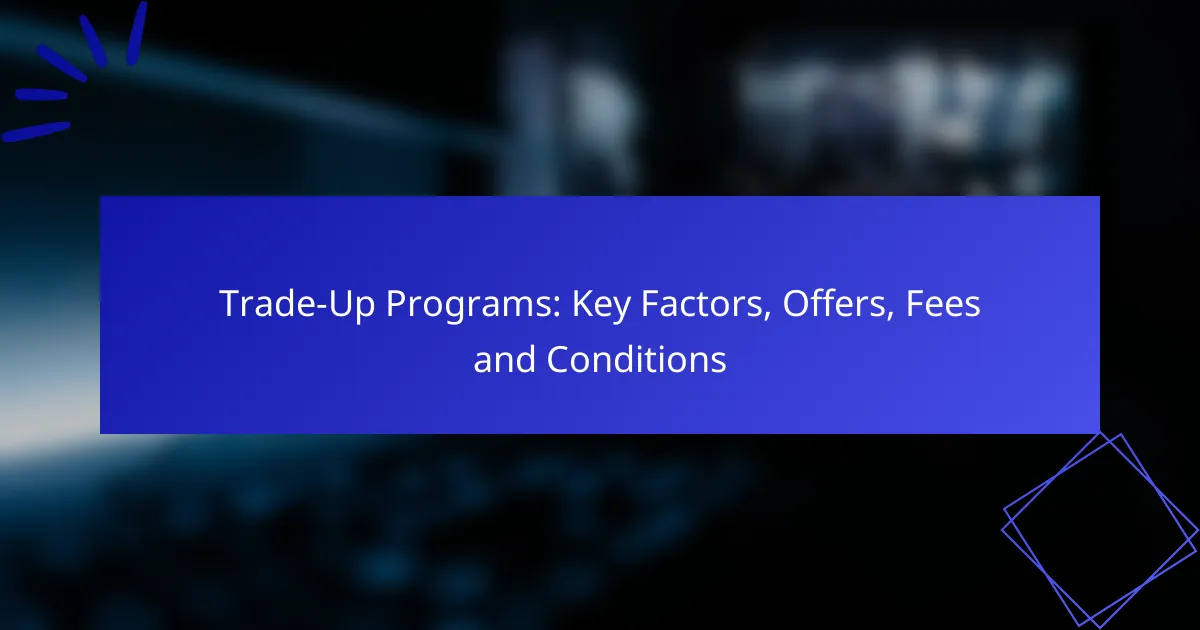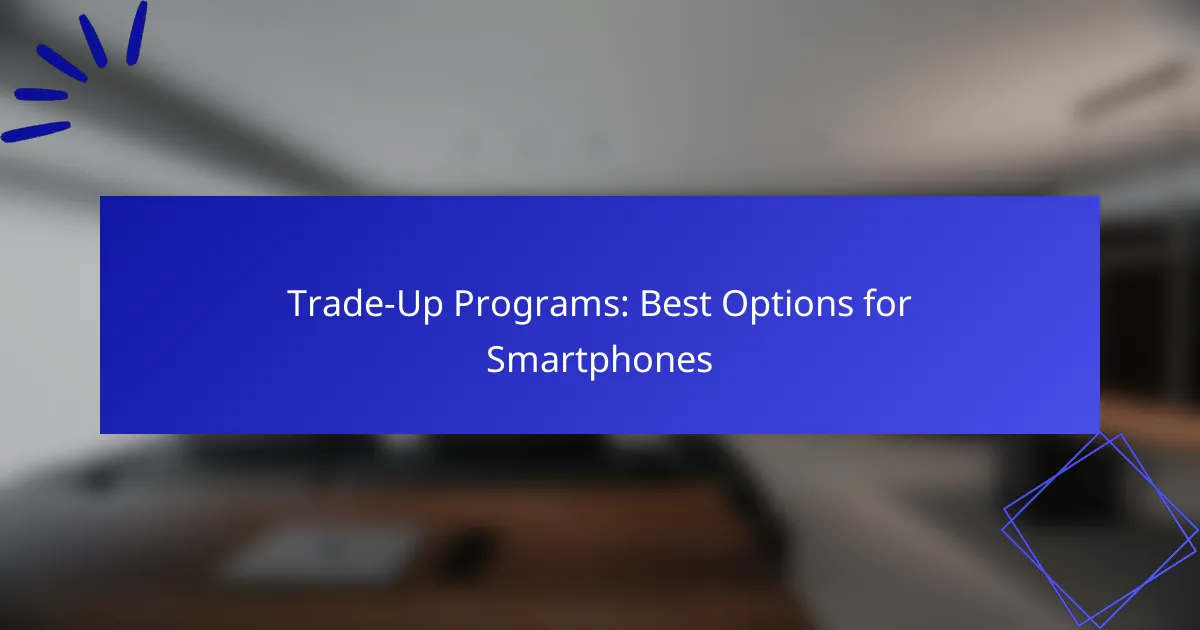Trade-up programs offer consumers a convenient way to exchange old devices for credit towards new purchases, with varying offers that may include cash back or discounts. Key factors to consider include eligibility requirements, device condition standards, and potential fees that could affect the overall value of the trade-in. Understanding these elements is essential for making informed decisions when upgrading your technology.

What are the key factors of trade-up programs?
Trade-up programs are designed to facilitate the exchange of old devices for credit towards new purchases. Key factors include eligibility requirements, device condition standards, trade-in value assessments, time limits for trade-ins, and necessary documentation.
Eligibility requirements
To participate in a trade-up program, users typically need to meet specific eligibility criteria. These may include having a qualifying device, being a resident of the country where the program operates, and being of a certain age, often 18 or older.
Some programs may also require customers to have an active account with the retailer or service provider, ensuring that they are established users of the brand.
Device condition standards
Device condition standards dictate the acceptable state of the item being traded in. Most programs categorize devices as “like new,” “good,” or “fair,” with each category affecting the trade-in value.
Devices with significant damage, such as cracked screens or water damage, may be rejected or receive a much lower value. It’s advisable to check the specific guidelines of the program to understand what qualifies as acceptable condition.
Trade-in value assessment
The trade-in value assessment determines how much credit a user will receive for their old device. This value is often based on the device’s age, model, and condition, with newer and well-maintained devices fetching higher credits.
Many programs provide online tools or calculators to estimate trade-in values, allowing users to get an idea of what to expect before proceeding with the trade.
Time limits for trade-ins
Time limits for trade-ins refer to the period within which users must complete their trade after initiating the process. This timeframe can vary significantly among programs, ranging from a few days to several weeks.
Missing the deadline may result in losing the opportunity for trade-in credit, so it’s crucial to be aware of these limits and act promptly.
Documentation needed
Documentation needed for trade-up programs typically includes proof of purchase and identification. Some programs may require additional documents, such as warranty information or account details.
Having all necessary paperwork ready can streamline the process and prevent delays, ensuring a smoother trade-in experience.
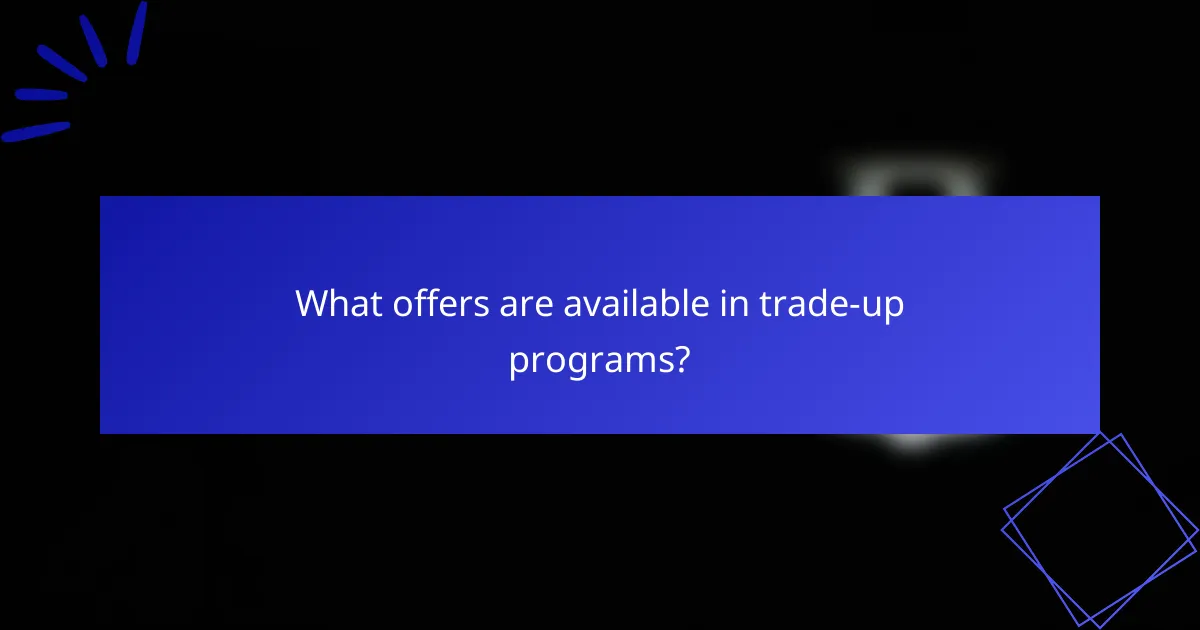
What offers are available in trade-up programs?
Trade-up programs provide consumers with opportunities to exchange their old devices for credit towards new purchases. These offers vary by brand and retailer, often including cash back, discounts on new products, or store credit.
Apple trade-in program
The Apple trade-in program allows customers to exchange their old Apple devices for credit towards a new purchase. Depending on the device’s condition and model, users can receive varying amounts of credit, typically ranging from low hundreds to over a thousand USD.
To participate, customers can visit an Apple Store or use the online trade-in tool. It’s essential to ensure that the device is in good working condition to maximize the trade-in value. Apple also provides a recycling option for devices that are not eligible for trade-in.
Samsung upgrade program
Samsung’s upgrade program enables customers to trade in their old devices for credit towards new Samsung products, often with promotional offers that enhance the value. The trade-in value can depend on the model and condition, generally falling within a similar range as Apple’s program.
Participants can complete the trade-in process online or at select retailers. Samsung frequently runs promotions that can increase trade-in values, so checking for current offers is advisable before proceeding.
Best Buy trade-in offers
Best Buy offers a trade-in program for various electronics, including smartphones, tablets, and laptops. Customers can receive store credit based on the device’s condition and model, with values typically ranging from tens to low hundreds of USD.
To trade in, customers can visit a Best Buy store or use the online trade-in estimator. It’s beneficial to compare offers from Best Buy with those from manufacturers like Apple and Samsung to ensure the best deal. Additionally, Best Buy often has seasonal promotions that can enhance trade-in values.
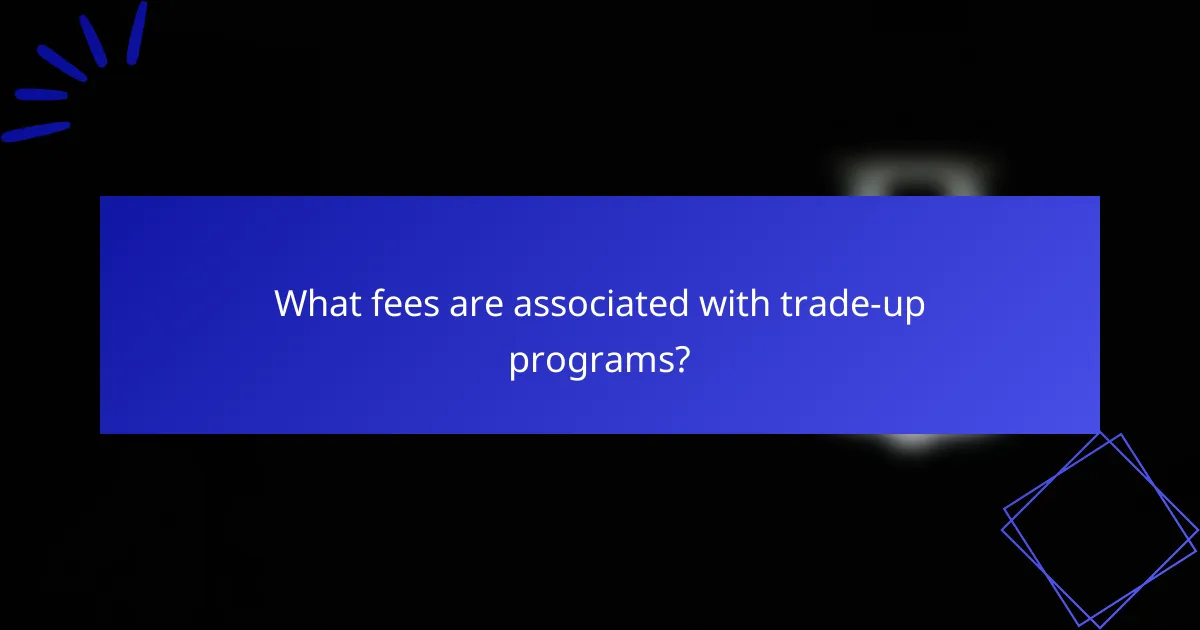
What fees are associated with trade-up programs?
Trade-up programs often involve various fees that can impact the overall value of the transaction. Understanding these fees is crucial for making informed decisions when upgrading your device.
Processing fees
Processing fees are charges that companies may impose to handle the trade-up transaction. These fees can vary widely, typically ranging from a few dollars to around 20 USD, depending on the retailer and the complexity of the trade-in process.
Before committing to a trade-up program, check the specific processing fees associated with your device. Some retailers may waive these fees during promotional periods, so it’s worth looking for special offers.
Shipping costs
Shipping costs can apply if you need to send your old device to the retailer. Many companies offer free shipping for trade-ins, but others may charge a fee that can range from 5 to 15 USD. Always confirm whether shipping is included in the trade-up offer.
Consider the total cost of shipping when evaluating trade-up options, especially if you are trading in a high-value item. Some retailers provide prepaid shipping labels, which can simplify the process and reduce out-of-pocket expenses.
Restocking fees
Restocking fees are charges that may apply if you decide to return a newly purchased device after trading in your old one. These fees typically range from 10% to 20% of the purchase price and can significantly affect your overall cost if you change your mind.
To avoid restocking fees, ensure you are satisfied with your new device before finalizing the trade-up. Familiarize yourself with the retailer’s return policy to understand any potential charges associated with returns.

What are the conditions for trade-up programs?
Trade-up programs typically require customers to meet specific conditions to qualify for discounts on new devices. These conditions often include the age and condition of the old device, brand limitations, and payment methods for the new purchase.
Device age limitations
Most trade-up programs impose age restrictions on devices, usually accepting models that are no more than a few years old. For instance, a program might only accept devices released within the last two to three years, ensuring that the trade-in is still relevant and valuable.
Additionally, the condition of the device plays a crucial role. Devices that show significant wear or damage may not qualify for the program or may receive a reduced trade-in value. Always check the specific criteria of the program you are considering.
Brand restrictions
Brand restrictions are common in trade-up programs, as many companies only accept devices from their own brand or select partners. For example, a smartphone manufacturer may only allow trade-ins for their own devices, excluding competitors’ products.
Understanding these restrictions is vital before initiating a trade-up. If you have a device from a different brand, you may need to explore third-party trade-in services that accept a wider range of brands.
Payment options for new purchases
When participating in a trade-up program, payment options for the new purchase can vary. Many programs offer discounts that can be applied directly to the purchase price, while others may provide store credit for future use.
Some retailers also allow financing options, enabling customers to pay for the new device in installments. Be sure to review the payment terms and conditions, as they can significantly impact your overall cost and budgeting.

How do trade-up programs compare across brands?
Trade-up programs vary significantly across brands, influencing the value you receive for your old devices. Factors such as trade-in values, conditions, and fees can impact your decision on which program to choose.
Apple vs Samsung trade-in values
Apple and Samsung both offer competitive trade-in values for their devices, but they can differ based on the model and condition. Generally, Apple tends to provide higher trade-in values for its latest iPhone models, often ranging from $200 to $600, while Samsung’s trade-in values for flagship models like the Galaxy series can range from $150 to $500.
When considering trade-in values, check the specific model you wish to trade in, as older devices may yield significantly lower returns. It’s advisable to compare offers directly on their respective websites to find the best deal for your device.
Best Buy vs Amazon trade-in conditions
Best Buy and Amazon have distinct trade-in conditions that can affect your experience. Best Buy typically requires devices to be in good working condition and may offer in-store credit, while Amazon allows for a broader range of conditions but often provides gift cards instead of cash.
For Best Buy, ensure your device is reset and free of personal data before trading in. Amazon’s process is straightforward, but be aware that they may adjust the offer based on the device’s condition upon receipt.
Consumer Electronics Association insights
The Consumer Electronics Association (CEA) highlights that trade-up programs are becoming increasingly popular as consumers seek to upgrade their devices more frequently. They emphasize the importance of understanding the terms and conditions, as well as the potential for value loss if devices are not in optimal condition.
CEA research indicates that consumers should consider timing their trade-ins with new product releases to maximize value. Additionally, they recommend comparing multiple trade-in options to ensure the best financial return on your old electronics.

What are the future trends in trade-up programs?
Future trends in trade-up programs are increasingly focused on sustainability, digital integration, and customer-centric models. Companies are adopting more eco-friendly practices and leveraging technology to enhance user experiences and streamline processes.
Key Factors Influencing Trade-Up Programs
Several key factors influence the effectiveness of trade-up programs. Consumer demand for sustainability drives companies to offer trade-in options that minimize waste. Additionally, technological advancements allow for better tracking and valuation of traded products, making the process more efficient.
Market competition is another significant factor. Companies that provide attractive trade-up offers can differentiate themselves and attract more customers. This often includes flexible terms and appealing incentives that encourage participation.
Offers and Incentives in Trade-Up Programs
Trade-up programs typically feature various offers and incentives to entice customers. Common incentives include discounts on new purchases, cash rebates, or store credit based on the value of the traded item. These offers can vary widely, often ranging from 10% to 30% off the new product price.
Some companies also provide additional bonuses for trading in multiple items or for loyalty program members. This tiered approach can significantly enhance the perceived value of the trade-up offer.
Fees and Conditions Associated with Trade-Up Programs
While trade-up programs can be beneficial, they often come with specific fees and conditions. Some programs may charge processing fees for evaluating the traded item, which can range from a few dollars to a percentage of the trade-in value. It’s essential to read the terms carefully to understand any potential costs.
Conditions may include the requirement that the traded item be in good working condition or meet specific age criteria. Failure to meet these conditions can result in reduced trade-in value or disqualification from the program.

